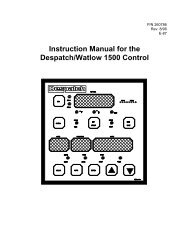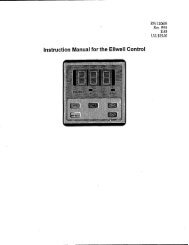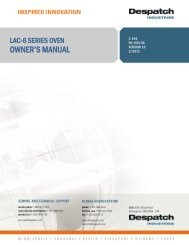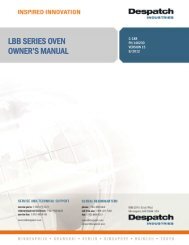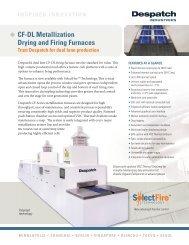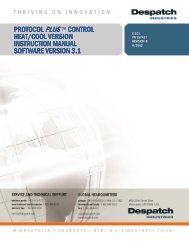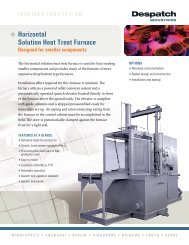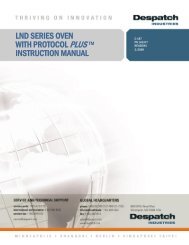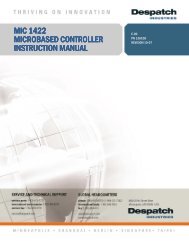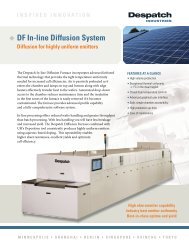Manual C-244 Rev 8/12 - Despatch Industries
Manual C-244 Rev 8/12 - Despatch Industries
Manual C-244 Rev 8/12 - Despatch Industries
You also want an ePaper? Increase the reach of your titles
YUMPU automatically turns print PDFs into web optimized ePapers that Google loves.
STACKABLE LCC/LCD OVENOWNER’S MANUALC-<strong>244</strong>P/N 320207VERSION 1.108/20<strong>12</strong>
PREFACEStackable LCC/LCD Oven Owner’s <strong>Manual</strong>2 Version 1.1<strong>Rev</strong>ision History<strong>Rev</strong>ision Date Author Description1 3/20<strong>12</strong> K. Livingston <strong>Rev</strong>ise for Protocol 3. <strong>Rev</strong>ised images forLCC-4.1.1 8/20<strong>12</strong> K. Livingston Miscellaneous revisions and additionsincluding LCC/LCD1-52V & 1-51NV OvenDoor update and HEPA filter installationupdate.Copyright © 20<strong>12</strong> by <strong>Despatch</strong> <strong>Industries</strong>.All rights reserved. No part of the contents of this manual may be reproduced, copied or transmitted in any form or by anymeans including graphic, electronic, or mechanical methods or photocopying, recording, or information storage andretrieval systems without the written permission of <strong>Despatch</strong> <strong>Industries</strong>, unless for purchaser's personal use.
ABOUT THIS MANUALStackable LCC/LCD Oven Owner’s <strong>Manual</strong>10 Version 1.1If the line voltage is higher than the nameplate rating, motors may run hot and draw excessiveamperageModel Volts * Amps Hertz Heater Phase KW Cord and PlugLCC1-16-4LCD1-16-4240 14.8 50/60 1 3 None, hardwiredLCC1-16N-4LCD1-16N-4240 14.0 50/60 1 3 None, hardwiredLCC1-51-4LCD1-51-4240 27.7 50/60 1 6 None, hardwiredLCC1-51N-4LCD1-51N-4240 27.7 50/60 1 6 None, hardwired*The LCC/LCD Oven is designed for 240 volts (see oven nameplate) will operate satisfactorilyon a minimum of 208 Volts, but will result in 25% reduced heater output. If your powercharacteristic is lower, contact <strong>Despatch</strong> <strong>Industries</strong>.Copyright © 20<strong>12</strong> by <strong>Despatch</strong> <strong>Industries</strong>.All rights reserved. No part of the contents of this manual may be reproduced, copied or transmitted in any form or by anymeans including graphic, electronic, or mechanical methods or photocopying, recording, or information storage andretrieval systems without the written permission of <strong>Despatch</strong> <strong>Industries</strong>, unless for purchaser's personal use.
Stackable LCC/LCD Oven Owner’s <strong>Manual</strong>SAFETYVersion 1.1 132.1.2. Door and PanelDanger!Electrical panels contain high voltage. Disconnect and lock outthe power supply before working inside any electrical panels.Failure to lock out the power supply can result in death or injury.The door and rear panel on the Stackable LCC/LCD Oven protect against hazards. Power isrequired to open the door and the oven heater is OFF when the door is open. Operation withoutthese safety devices in place creates hazards that the doors and covers are intended to render safefor personnel.The door requires a <strong>Manual</strong> Override Key for use when power is off. The door and panel thatrequire a tool to open are part of the safety system of the Stackable LCC/LCD Oven. Do not openthe door while the machine is running.2.2. MaintenanceOnly qualified and trained personnel should perform maintenance or repair.2.3. Electrical PowerOnly qualified and trained personnel should perform electrical maintenance or electrical repair.Danger!Contact with energized electrical sources may result in seriousinjury or death.Before performing maintenance, disconnect all electrical power from the machine. Use apadlock and lockout all disconnects feeding power to the machine.Never clean, or repair the oven when in operation.Unauthorized alterations or modifications to Stackable LCC/LCD Oven are strictly forbidden.Never modify any electrical circuits. Unauthorized modifications can impair the function andsafety of the Stackable LCC/LCD Oven.2.4. FireKeep the Stackable LCC/LCD Oven clean and free of scrap materials, oil or solvents to preventthe possibility of fire. In the event of fire, use a fire extinguisher as follows.1. De-energize the machine immediately by turning OFF the DISCONNECT SWITCH.2. Turn off the remote main disconnect (customer supplied disconnect).3. Extinguish the fire.Copyright © 20<strong>12</strong> by <strong>Despatch</strong> <strong>Industries</strong>.All rights reserved. No part of the contents of this manual may be reproduced, copied or transmitted in any form or by anymeans including graphic, electronic, or mechanical methods or photocopying, recording, or information storage andretrieval systems without the written permission of <strong>Despatch</strong> <strong>Industries</strong>, unless for purchaser's personal use.
SAFETYStackable LCC/LCD Oven Owner’s <strong>Manual</strong>14 Version 1.1Danger!Always disconnect all power before extinguishing a fire.Attempting to extinguish a fire in a machine connected toelectrical power can result in serious injury or death!2.5. Equipment Lockout RequirementsTo prevent injury or equipment damage during inspection or repair, the Stackable LCC/LCDOven must be locked out.2.5.1. Emergency StopWhen a risk of personal injury or damage to the Stackable LCC/LCD Oven exists, turn OFF theDISCONNECT SWITCH on the front of the oven. This shuts off all electrical power to the oven.Copyright © 20<strong>12</strong> by <strong>Despatch</strong> <strong>Industries</strong>.All rights reserved. No part of the contents of this manual may be reproduced, copied or transmitted in any form or by anymeans including graphic, electronic, or mechanical methods or photocopying, recording, or information storage andretrieval systems without the written permission of <strong>Despatch</strong> <strong>Industries</strong>, unless for purchaser's personal use.
THEORY OF OPERATIONStackable LCC/LCD Oven Owner’s <strong>Manual</strong>16 Version 1.1ductwork may be easily removed for cleaning. Heater frame, fan wheel and motor shaft areconstructed of stainless steel.Two electropolished stainless steel wire shelves are provided. The shelves are removable andadjustable on two inch centers.The LCC/LCD series design offers a stackable oven body. Multiple oven systems of two or threeoven stack options are available. When operating multiple ovens, network the <strong>Despatch</strong> Protocol3 controllers together with a Modbus communication option. Use the optional <strong>Despatch</strong> ProtocolManager software to enable customer PC control of multiple ovens.Stackable units are available in air or nitrogen atmosphere models.Nitrogen atmosphere models are noted with an N suffix. Modelnumbers beginning with “LL*1-*” do not use a HEPA filter.3.2. The Protocol 3 ControllerThe Protocol 3 is a microprocessor based digital temperature controller designed for simple andflexible oven operation (Figure 2). The Protocol 3 controller operates as a dual-functioningcontroller/high limit instrument. The control portion utilizes a time-proportioning voltage signalto control heating devices with minimal temperature fluctuations.The high limit portion protects the product and/or the oven from overheating. If the product beingprocessed has a critical high temperature limit, the high limit setpoint should be set to atemperature somewhat below the temperature at which the product could be damaged. If theproduct does not have a critical high temperature limit, the high limit setpoint should be set 5 to15 degrees higher than the maximum programmed setpoint at which the oven will operate.The Protocol 3 controller provides three primary operating modes: <strong>Manual</strong>: Oven operates continuously at a fixed temperature until turned off. Timer: Oven operates at a fixed temperature for a user-selected time period, and thenautomatically turns off. Profile: Temperaturesincrease or decrease asdefined by 255 segments thatcan be allocated to 64 rampand soak profiles. Theprofiles can be linked toprovide additionaltemperature combinations.<strong>Rev</strong>iew the Protocol 3 ControllerOwner’s <strong>Manual</strong> for moreinformation.Figure 2. Protocol 3 Operator Interface.Copyright © 20<strong>12</strong> by <strong>Despatch</strong> <strong>Industries</strong>.All rights reserved. No part of the contents of this manual may be reproduced, copied or transmitted in any form or by anymeans including graphic, electronic, or mechanical methods or photocopying, recording, or information storage andretrieval systems without the written permission of <strong>Despatch</strong> <strong>Industries</strong>, unless for purchaser's personal use.
Stackable LCC/LCD Oven Owner’s <strong>Manual</strong>THEORY OF OPERATIONVersion 1.1 173.3. HEPA FiltersThe Stackable LCC/LCD Ovens use HEPA (High Efficiency Particulate Air) filters limitparticulate size in the work chamber to 0.3 microns or less. Two different types of filters aretypically used. While both filters are high-temperature filters in that they are designed for use inthermal processing equipment, the “standard” HEPA filter is rated to 260°C ( 500°F) while the“high-temperature” HEPA filter is rated to 350°C (662°F).Each LCC/LCD oven uses one of two types of HEPA filters,depending on the oven’s maximum temperature. Ovens that canbe heated to 260°C (500°F) use the Standard HEPA filter. Ovensthat can be heated to 350°C (662°F) use the High-TemperatureHEPA filter.However, customers requiring a higher ramp rate whileoperating equipment below 260°C (500°F) may still choose to usethe high-temperature HEPA filter: Standard HEPA filter ramp rate: 1.25°C (34.25°F)/minute High-Temperature HEPA filter ramp rate: 5°C(41°F)/minuteLCC oven chamber temperature transitions must not exceed1.5°C/minute to maintain class 100 chamber conditions. For ramprates greater than 1.5°C/minute and up to 5°C/minute, the LCD modelwill maintain class 100 chamber conditions.3.3.1. Definitions Binder: Organic substance used in filter construction to provide the media with structuralstrength Burn-Off: Process for eliminating the binder and D.O.P. contained in the filter from themanufacturing and testing function. D.O.P.: Dioctyl Phthalate - Aerosol particles of submicron size used in testing phase to spotdefects or measure filter efficiency. HEPA: High Efficiency Particulate AirFilter Packaging, Shipping and HandlingPackaging practice varies among the filter unit manufacturers. Filterunits are typically packaged in cardboard cartons with varyingapproaches for strengthening the container and making it impactresistant.Shipping cartons are typically marked with a vertical arrowand "This Side Up" (Figure 3). A filter unit is placed in the carton sothe pleated folds are vertical (running from top to bottom), versusside to side.THIS SIDE UPFigure 3. This Side Up Graphic.Copyright © 20<strong>12</strong> by <strong>Despatch</strong> <strong>Industries</strong>.All rights reserved. No part of the contents of this manual may be reproduced, copied or transmitted in any form or by anymeans including graphic, electronic, or mechanical methods or photocopying, recording, or information storage andretrieval systems without the written permission of <strong>Despatch</strong> <strong>Industries</strong>, unless for purchaser's personal use.
THEORY OF OPERATIONStackable LCC/LCD Oven Owner’s <strong>Manual</strong>18 Version 1.1Ship, handle, store and install HEPA filters with pleats positionedvertically. Horizontally-positioned pleats risk breaking at the adhesiveline of the filter medium. Horizontally-positioned pleats also collectentrapped material on “shelves.” The accumulated weight of theentrapped material may cause sag and lead to early failure of the filterunit.The filter is typically shipped in the original carton or package provide by the filter manufacturer.This carton or package provides good storage and maximum protection from dirt and moisture.Store and move HEPA filters upright in the shipping carton. Minimize handling of the filter.During installation, remove the filter from the shipping carton and install directly into the oven.If an unpackaged HEPA filter unit must be placed with its face on the floor or other surface, clearthe surface entirely of every object or irregularity which might damage the filter pack.3.3.2. HEPA Filter Validation Testing<strong>Despatch</strong> <strong>Industries</strong> guarantees the HEPA filters will meet specified efficiency ratings when thefollowing recommendations are followed: The filter is properly installed The filter is run at or below 200°C, at a constant temperature The filter is run before burn-in3.3.2.1. D.O.P. TestingCaution!<strong>Despatch</strong> does not recommend D.O.P. filter testing.D.O.P. testing uses aerosol particles of submicron size to spot defects or measure filter efficiency.Degenerative by-products of this test are distributed throughout the oven chamber upon heat-up.<strong>Despatch</strong> does not recommend D.O.P. filter testing.3.3.2.2. Class 100 Testing<strong>Despatch</strong> guarantees a Class 100 environment within the oven. This classification is based onmeasurement of the particulate level within the oven work chamber.Copyright © 20<strong>12</strong> by <strong>Despatch</strong> <strong>Industries</strong>.All rights reserved. No part of the contents of this manual may be reproduced, copied or transmitted in any form or by anymeans including graphic, electronic, or mechanical methods or photocopying, recording, or information storage andretrieval systems without the written permission of <strong>Despatch</strong> <strong>Industries</strong>, unless for purchaser's personal use.
Stackable LCC/LCD Oven Owner’s <strong>Manual</strong>THEORY OF OPERATIONVersion 1.1 19Class 100 testing may be performed before or after a proper filter burn-in procedure has beenperformed. <strong>Despatch</strong> guarantees Class 100 condition measurements based on two methods of test.The direct method employs an extraction-type particulate analyzer. The indirect method involvesparticle settling over a specified period of time onto a clean disk.3.3.2.3. Validation Testing<strong>Despatch</strong> recommends the following test sequence for pharmaceutical Class 100 ovens.1. Proper installation of the HEPA filters (Section 0).2. Ambient air challenge to determine integrity of oven chamber and filter gaskets.3. Proper filter burn-off procedure.4. Class 100 testing inside the work chamber.3.3.2.4. HEPA Filter Burn-off Process Not NecessaryHEPA filters contain a binder material which protects the filter media during production andshipping. Smoke produced from burning this binder at elevated temperatures is undesirableduring normal oven operation. Burning off the binder will ensure a clean process at elevatedtemperatures.However, when the binder is burned out of the filter media, the filter becomes veryfragile: too fragile to withstand normal shipping and handling. For this reason, <strong>Despatch</strong> does notperform the burn-off procedure. The burn-off process is not necessary at temperatures under200°C.3.3.3. HEPA Filter Unit ReplacementPeriodic replacement the HEPA filter unit due to: Resistance, or pressure drop, across the filter unit. Maximum level of resistance in inches(water gauge) will vary depending upon the operation of the filter and the available fancapacity. Adequate fan capacity must be available. Loss of efficiency (leakage), determined from air-sampling measurements made downstreamof the filter unit. Visible damage or rupture of the filter media in a unit. Change in process application. Excessive build-up of lint or combustible particulate matter on the filter unit. Water droplets in airstream through filter, free water (RH = 100%), will saturate filter veryquickly and may cause burnout or holes in burned off filter media. High level of radiation in the vicinity of the filter unit.3.3.4. HEPA Filter: Magnehelic Pressure GaugeThe LCC Series oven is equipped with a Magnehelic pressure gauge which measures the pressurein front of the HEPA filter (Figure 4). As the filter becomes dirty, pressure increases. <strong>Despatch</strong>Copyright © 20<strong>12</strong> by <strong>Despatch</strong> <strong>Industries</strong>.All rights reserved. No part of the contents of this manual may be reproduced, copied or transmitted in any form or by anymeans including graphic, electronic, or mechanical methods or photocopying, recording, or information storage andretrieval systems without the written permission of <strong>Despatch</strong> <strong>Industries</strong>, unless for purchaser's personal use.
THEORY OF OPERATIONStackable LCC/LCD Oven Owner’s <strong>Manual</strong>20 Version 1.1recommends changing the filter when the pressure is 1” w.c. greater than when the filter was firstinstalled (Refer to section 4.3 for filter replacement).Since pressure can be affected by many factors involved in theinstallation, it is important to record the pressure of a new filter asa baseline. Recorded pressure readings allow for new readings tobe periodically checked against this baseline. Use Table 2 forrecording this information (See Section 8.1 for a blankworksheet).For a nitrogen atmosphere oven, pressure readings also give anindication of the integrity of the seals. If the pressure recorded inColumns D or E decrease over time, inspect the oven seals.Figure 4. Magnehelic PressureGauge Measures Pressure in front ofthe HEPA filter.Table 2. HEPA Filter Pressure Reading Worksheet.A B C D E FDate Comments Pressure(inches ofwater) 8TypicalValuesFilter firstinstalledPressure with:150 SCFH (LCC1-16); 200 SCFH(LCC1-51) nitrogenpurge 92-3” 1.5-2” above valuein Column CPressure with:75 SCFH (LCC1-16); 150 SCFH(LCC1-51) nitrogenmaintain90.5-1” above valuein Column COvenTemperature60°C8 With Purge and Maintain valves off for a nitrogen atmosphere oven. Cooling fan off for an airatmosphere oven.9 For a nitrogen atmosphere oven only.Copyright © 20<strong>12</strong> by <strong>Despatch</strong> <strong>Industries</strong>.All rights reserved. No part of the contents of this manual may be reproduced, copied or transmitted in any form or by anymeans including graphic, electronic, or mechanical methods or photocopying, recording, or information storage andretrieval systems without the written permission of <strong>Despatch</strong> <strong>Industries</strong>, unless for purchaser's personal use.
Stackable LCC/LCD Oven Owner’s <strong>Manual</strong>ASSEMBLY & SETUPVersion 1.1 214. Assembly & SetupAssembly and Setup provides directions for unpacking and installing your LCC/LCD.4.1. Unpack & Inspect The LCC/LCD OvenRemove all packing materials and thoroughly inspect the oven for any damage that might haveoccurred during shipment. Note whether the carton and plastic cover sheet inside carton are still in good condition Observe all outside surfaces and corners of the oven for scratches and dents Check oven controls and indicators for normal movement, bent shafts, cracks, chips ormissing parts such as knobs and lenses Check the door and latch for smooth operation (Figure 5) Check the filter carton for damageWarning!The LCC door requires a <strong>Manual</strong> Override Key for use whenpower is OFF. The door and panel that require a tool to open arepart of the safety system of the Stackable LCC/LCD Oven. Donot attempt to permanently mount the <strong>Manual</strong> Override Key.Do not remove torx screw from door release mechanism. <strong>Manual</strong>Override Key cannot be permanently mounted.Figure 5. Door Lock <strong>Manual</strong> Override Key (LCC/LCD/LLC/LLD).Copyright © 20<strong>12</strong> by <strong>Despatch</strong> <strong>Industries</strong>.All rights reserved. No part of the contents of this manual may be reproduced, copied or transmitted in any form or by anymeans including graphic, electronic, or mechanical methods or photocopying, recording, or information storage andretrieval systems without the written permission of <strong>Despatch</strong> <strong>Industries</strong>, unless for purchaser's personal use.
ASSEMBLY & SETUPStackable LCC/LCD Oven Owner’s <strong>Manual</strong>22 Version 1.14.1.1. If Damaged During ShippingIf damage occurred during shipping:1. Contact the shipper immediately and file a written damage claim.2. Contact <strong>Despatch</strong> <strong>Industries</strong> (1-800-473-7373 or 1-952-469-8230 or service@despatch.com)to report your findings and to order replacement parts for those damaged or missing. Send acopy of your filed damage claims to <strong>Despatch</strong> industries (<strong>Despatch</strong> <strong>Industries</strong>, 8860 207 thStreet, Lakeville, MN 555044, USA).3. Check the packing list to ensure you received all the specified components of the ovensystem. If any items are missing, contact <strong>Despatch</strong> <strong>Industries</strong> to have missing productsforwarded to you.4. Complete the warranty card and mail it to <strong>Despatch</strong> within 15 days after receipt of theequipment.4.2. Set-up The LCC/LCD Oven4.2.1. Select Oven LocationWarning!Do not use the oven in wet, corrosive or explosive atmospheresunless this oven is specifically designed for a specialatmosphere.4.2.1.1. Single Oven Placement RequirementsBench top (or other framework) capable of holding at least 250 Lbs (113.4 Kgs).A minimum of three (3) inches (7.6 cm) available in the rear of the oven for properventilation.Leave room at the oven sides and rear for maintenance.Oven exhaust opening is at the rear of the left side of the oven. Allow at least two (2) inches(5.1 cm) clearance here as well. The oven may be placed next to another cabinet on its right,or next to another oven, with three-quarters of an inch (19 mm) clearance (measure with dooropen).Plumb and level the oven to assure proper heat distribution and operation of all mechanicalcomponents.4.2.1.2. Multiple Oven Placement RequirementStack up to three ovens vertically, with or without the optional framework (base) supplied by<strong>Despatch</strong>.Copyright © 20<strong>12</strong> by <strong>Despatch</strong> <strong>Industries</strong>.All rights reserved. No part of the contents of this manual may be reproduced, copied or transmitted in any form or by anymeans including graphic, electronic, or mechanical methods or photocopying, recording, or information storage andretrieval systems without the written permission of <strong>Despatch</strong> <strong>Industries</strong>, unless for purchaser's personal use.
Stackable LCC/LCD Oven Owner’s <strong>Manual</strong>ASSEMBLY & SETUPVersion 1.1 23For the LCC1-51 oven model, only two ovens may be stackedvertically.Supporting surface must be capable of holding three ovens (750 Lbs or 340.2 Kg) or theweight of two LCC1-51 oven models.Use the holes in the rear oven feet to bolt the ovens together by removing the hole plugs inthe top of the mating oven beneath.4.2.2. Oven Utility ConnectionsUtility connections vary slightly on different LCC/LCD models. Table 3 lists the connectionpurposes and parameters. Refer to Figure 6 for visual reference.Table 3. Oven Utility Connections.Connection(Figure 6)LCC/LCD Air Atmosphere withoptional Water-Cooled ModelsLCC/LCD Nitrogen AtmosphereModels with standard water-coolingNITROGENINLET Clean Dry Air Inlet (70-80 psi(4.83-5.52 bar)) Nitrogen Inlet (70-80 psi (4.83-5.52bar)) Purge water from coil prior toheating oven Purge nitrogen, clean dry air andwater from coil prior to heating the ¼” NPT female brassovenconnections provided 1/4” NPT female brass connectionsprovided.WATEROUTLET During cooling cycle, water flows through the water coil and out thisconnection 3/8” NPT female brass connections provided Piping must be rated for up to 250 °F (<strong>12</strong>1°C)WATERDRAIN At the end of a cooling cycle, Nitrogen or Clean Dry Air is purged throughthe water coil. Water and pressurized nitrogen/air exit this connection for 30seconds. Must be connected to gravity style drain (no backpressure). 3/8” NPT female brass connections are provided. Piping must be rated for up to 250 F (<strong>12</strong>1 C)WATERINLETWater Inlet for cooling3/8” NPT female brassconnections provided Requires 2 GPM flow at 61 °F(16°C) to meet published coolingrates.Maximum Pressure 100 PSI(6.89 Bar)Water Inlet for cooling3/8” NPT female brass connectionsprovided Requires 3 GPM flow at 61 °F(16°C) to meet published coolingrates. Maximum Pressure 100 PSI (6.89Bar)4.2.2.1. Nitrogen With Water-Cooled Models1. Connect nitrogen supply line to NITROGEN INLET at the connections panel (Figure 6).Copyright © 20<strong>12</strong> by <strong>Despatch</strong> <strong>Industries</strong>.All rights reserved. No part of the contents of this manual may be reproduced, copied or transmitted in any form or by anymeans including graphic, electronic, or mechanical methods or photocopying, recording, or information storage andretrieval systems without the written permission of <strong>Despatch</strong> <strong>Industries</strong>, unless for purchaser's personal use.
ASSEMBLY & SETUPStackable LCC/LCD Oven Owner’s <strong>Manual</strong>24 Version 1.1Nitrogen pressure supplied should be greater the 70 psi (4.83 bar) butnot more than 80 psi (5.52 bar).2. Install water connection for cooling coils to WATER INLET (Figure 6). Verify the valve on theflowmeter is turned OFF, that is, fully clockwise.Nitrogen inletFlow-meter valveWater drainWater inletWater outletFigure 6. LCC/LCD Connections Panel.Water pressure supplied to the oven must not exceed 100 psi(6.89 bar). <strong>Despatch</strong> recommends installing a regulator toprevent surging.3. Check for leaks by slowly opening the valve on the flowmeter and allowing any air to bleedout.Caution!Failure to allow air to bleed from the flowmeter may damage theflowmeter. Bleed air from the flowmeter after every instance ofshutting off the water supply.Copyright © 20<strong>12</strong> by <strong>Despatch</strong> <strong>Industries</strong>.All rights reserved. No part of the contents of this manual may be reproduced, copied or transmitted in any form or by anymeans including graphic, electronic, or mechanical methods or photocopying, recording, or information storage andretrieval systems without the written permission of <strong>Despatch</strong> <strong>Industries</strong>, unless for purchaser's personal use.
Stackable LCC/LCD Oven Owner’s <strong>Manual</strong>ASSEMBLY & SETUPVersion 1.1 254. Adjust the flowmeter to the recommended 3 gpm (11.4 lpm).5. Complete the drain connection on oven side by connecting WATER OUTLET to the closed loopsystem (Figure 6).WATER DRAIN must be left open-to-atmosphere. Make closedloopconnections using WATER OUTLET (Figure 6).Warning!Never allow WATER DRAIN to be plugged. A hot oven generatesa small amount of steam when the water is first turned on.Steam can burn skin.Caution!Design the drain system to prevent operator injury from hightemperature or pressure buildup. Piping must withstand shortperiods of up to 500 °F (260°C) temperatures (662 °F (350°C) forLCD ovens). Insulate drain lines or install warning labels statingthe potential high temperature or pressure hazard.4.2.2.2. Air Atmosphere with Optional Water Cooling Model1. Connect Clean Dry Air (CDA) line to DRY AIR 100 PSI at the connections panel (Figure 6).2. Install water connection for cooling coils to WATER INLET (Figure 6). Verify the valve on theflowmeter is turned OFF, that is, fully clockwise.Clean Dry Air pressure supplied should be at 100 psi (6.9 bar).Water pressure supplied to the oven must not exceed 100 psi(6.9 bar). <strong>Despatch</strong> recommends installing a regulator to preventsurging.3. Check for leaks by slowly opening the valve on the flowmeter and allowing any air to bleedout.Copyright © 20<strong>12</strong> by <strong>Despatch</strong> <strong>Industries</strong>.All rights reserved. No part of the contents of this manual may be reproduced, copied or transmitted in any form or by anymeans including graphic, electronic, or mechanical methods or photocopying, recording, or information storage andretrieval systems without the written permission of <strong>Despatch</strong> <strong>Industries</strong>, unless for purchaser's personal use.
ASSEMBLY & SETUPStackable LCC/LCD Oven Owner’s <strong>Manual</strong>26 Version 1.1Caution!Failure to allow air to bleed from the flowmeter may damage theflowmeter. Bleed air from the flowmeter after every instance ofshutting off the water supply.4. Adjust the flowmeter to the recommended 3 gpm (11.4 lpm).5. Complete the drain connection on oven side by connecting WATER OUTLET to the closed loopsystem (Figure 6).WATER DRAIN must be left open-to-atmosphere. Make closedloopconnections using WATER OUTLET (Figure 6).Warning!Never allow WATER DRAIN to be plugged. A hot oven generatesa small amount of steam when the water is first turned on.Steam can burn skin.Caution!Design the drain system to prevent operator injury from hightemperature or pressure buildup. Piping must withstand shortperiods of up to 500 °F (260°C) temperatures (LCD ovens: 662 °F(350°C). Insulate drain lines or install warning labels stating thepotential high temperature or pressure hazard.4.2.3. Exhaust ConnectionsThe LCC/LCD Exhaust port is located on the left side of the oven (Figure 7). Table 4 lists therequirements for the exhaust stack for the LCC/LCD Oven.Copyright © 20<strong>12</strong> by <strong>Despatch</strong> <strong>Industries</strong>.All rights reserved. No part of the contents of this manual may be reproduced, copied or transmitted in any form or by anymeans including graphic, electronic, or mechanical methods or photocopying, recording, or information storage andretrieval systems without the written permission of <strong>Despatch</strong> <strong>Industries</strong>, unless for purchaser's personal use.
Stackable LCC/LCD Oven Owner’s <strong>Manual</strong>ASSEMBLY & SETUPVersion 1.1 27Figure 7. Exhaust Port on the Left Side of the LCC/LCD Oven.Table 4. Exhaust Connection Requirements.LCC/LCD1-16 ModelsLCC/LCD1-51ModelsSize1.88” x 2.88” (4.8 cm x 7.3 cm)Flow 35 cfm (991.5 lpm) 73 CFM (2067 lpm)TemperatureLCC and LLC series:500 °F (260°C)LCC and LLC series:500 °F (260°C)LCD and LLD series:662 °F (350°C)LCD and LLD series:662 °F (350°C)4.2.4. Wiring & Power ConnectionsThe oven must be hardwired directly to the disconnect switch onthe equipment panel (Figure 9).Danger!All grounding and safety equipment must be in compliance withapplicable codes, ordinances and accepted safe practices. Run line voltage power through the conduit from rear of oven to front (Figure 9). Consultelectrical drawings included with the oven for details. Access the conduit and Disconnect Switch by opening the front panel (Figure 8).Copyright © 20<strong>12</strong> by <strong>Despatch</strong> <strong>Industries</strong>.All rights reserved. No part of the contents of this manual may be reproduced, copied or transmitted in any form or by anymeans including graphic, electronic, or mechanical methods or photocopying, recording, or information storage andretrieval systems without the written permission of <strong>Despatch</strong> <strong>Industries</strong>, unless for purchaser's personal use.
ASSEMBLY & SETUPStackable LCC/LCD Oven Owner’s <strong>Manual</strong>28 Version 1.1Figure 8. Open the front panel for access.Connect the line voltage power to the disconnect switch labeled LINE CONNECTION (Figure9).Conduit on rear of ovenConnect line voltagepower to DisconnectSwitch labeled LINECONNECTION.Line voltage poweremerges from conduit onfront of oven here.Route line voltage powerthrough conduitFigure 9. Conduit entrance at rear of oven and open front panel.Copyright © 20<strong>12</strong> by <strong>Despatch</strong> <strong>Industries</strong>.All rights reserved. No part of the contents of this manual may be reproduced, copied or transmitted in any form or by anymeans including graphic, electronic, or mechanical methods or photocopying, recording, or information storage andretrieval systems without the written permission of <strong>Despatch</strong> <strong>Industries</strong>, unless for purchaser's personal use.
Stackable LCC/LCD Oven Owner’s <strong>Manual</strong>ASSEMBLY & SETUPVersion 1.1 294.3. HEPA Filter InstallationNot all LCC/LCD ovens come equipped with a HEPA filter. This HEPA filter installation sectionapplies only to ovens designed for ISO Class 5 (Class 100) use, which are equipped with a HEPAfilter. For a complete explanation of model numbers, refer to Section 1.5.1.Two different types of filters are typically used. While both filters are high-temperature filters inthat they are designed for use in thermal processing equipment, the “standard” HEPA filter israted to 260°C (500°F) while the “high-temperature” HEPA filter is rated to 350°C (662°F).Each LCC/LCD oven uses one of two types of HEPA filters,depending on the oven’s maximum temperature. Ovens that canbe heated to 260°C (500°F) use the Standard HEPA filter. Ovensthat can be heated to 350°C (662°F) use the High-TemperatureHEPA filter.However, customers requiring a higher ramp rate whileoperating equipment below 260°C (500°F) may still choose touse the high-temperature HEPA filter: Standard HEPA filter ramp rate: 1.25°C (2.25°F)/minute High-Temperature HEPA filter ramp rate: 5°C (9°F)/minuteWarning!Make certain power is disconnected from the oven beforeremoving or replacing the HEPA filter. Observe all applicablesafety procedures.Caution!The HEPA filter is fragile and care must be taken to avoiddamage during installation. If a filter unit is dropped, whether inthe carton or not, examine it carefully for damage.Caution!The HEPA filter must be installed so that unfiltered air cannotleak past the unit.Refer to installation instructions provided by filter manufacturerfor additional details..Copyright © 20<strong>12</strong> by <strong>Despatch</strong> <strong>Industries</strong>.All rights reserved. No part of the contents of this manual may be reproduced, copied or transmitted in any form or by anymeans including graphic, electronic, or mechanical methods or photocopying, recording, or information storage andretrieval systems without the written permission of <strong>Despatch</strong> <strong>Industries</strong>, unless for purchaser's personal use.
ASSEMBLY & SETUPStackable LCC/LCD Oven Owner’s <strong>Manual</strong>30 Version 1.1Sweep floor clear of nuts, bolts and other protrusions whichmay damage the unit.Do not drop or jar the filter carton.1. Remove new filter from cartonNoticeDo not attempt to repair a damaged filter unit—particularly themedium. Any unit so repaired must be retested to assure thathidden damage does not exist which might reduce filteringefficiency. Repair and retest is not economical for most users.a. Place carton on floor.b. Tilt the carton on one corner. Handle the carton at opposing corners.c. Remove sealing tape and fold back flaps of carton.d. Gently upend the filter to place the exposed end of the filter on the floor. Do not jar thefilter.e. Pull the carton from the filter unit. Be careful to not pull the filter from the carton.2. Inspect the filter.a. Visually inspect the new gasket(s) for damage during handling.b. Use a strong lamp to examine the exposed areas of both faces for evidence of breaks,cracks, or pinholes (Figure 10).If a strong lamp is unavailable,use a flashlight in a darkenedroom.c. Look for visible defects withthe light projected along thefull length of each channelcreated by the separators.Translucent spots may notnecessarily indicate holes orcracks but may simply bevariations in thickness of thefilter medium.d. Check that the adhesive sealaround the filter unit faces arecomplete and unbroken.e. Check frame corner joints foradhesive sealing and tightness.f. Check that gaskets arecemented firmly to the filter Figure 10. Example HEPA Filter (Silicone-free) and Close-Up.frame and that gasket piecesare undamaged and butted ormated at the joints.Copyright © 20<strong>12</strong> by <strong>Despatch</strong> <strong>Industries</strong>.All rights reserved. No part of the contents of this manual may be reproduced, copied or transmitted in any form or by anymeans including graphic, electronic, or mechanical methods or photocopying, recording, or information storage andretrieval systems without the written permission of <strong>Despatch</strong> <strong>Industries</strong>, unless for purchaser's personal use.
Stackable LCC/LCD Oven Owner’s <strong>Manual</strong>ASSEMBLY & SETUPVersion 1.1 31Opened pleats in the filter media are normal and result from thetempering process.3. Pull shelves from the oven and set aside (Figure 11).Danger!Make certain power is disconnected from the oven beforeremoving or replacing the HEPA filter.4. Loosen the three screws at the upper and lower corners of the right rear of the chamber(Figure 11).a. Pull out the shelf support/duct as a single unit and set it aside.5. Remove the brass nuts and washers from the rods that hold the filter frame in place.a. Set aside and reuse these nuts to hold the new filter in place.b. Discard the old filter in accordance with your company’s disposal policies.Loosen three screws to remove the entire inner casingassembly as a single unitLoosen ¼ turn using 5/16inch nut driverRemove shelves before installing HEPA FILTERSFigure 11. Remove inner casing to install HEPA filter.Copyright © 20<strong>12</strong> by <strong>Despatch</strong> <strong>Industries</strong>.All rights reserved. No part of the contents of this manual may be reproduced, copied or transmitted in any form or by anymeans including graphic, electronic, or mechanical methods or photocopying, recording, or information storage andretrieval systems without the written permission of <strong>Despatch</strong> <strong>Industries</strong>, unless for purchaser's personal use.
ASSEMBLY & SETUPStackable LCC/LCD Oven Owner’s <strong>Manual</strong>32 Version 1.16. LCC1-16 only: remove the filter frame,which will be reinstalled after filterinstallation.7. For all LCC/LCD Ovens: Install HEPAfilter:a. For the High-temperature HEPAfilter:i. Place the filter with thetriangular gasket set againstthe oven wall and the glassbraid set against the clampingplate (Figure <strong>12</strong>).ii. Tighten the nuts until thetriangular gasket iscompressed to a thickness of0.16 inch (0.4 cm).b. For the Standard HEPA filter:i. Place the filter with the gasketset against the oven wall(Figure 13).ii. Tighten the four nutsalternately for a torque of 28(+/- 3 in-lbs.).iii. Be careful not to over tighten.6. Reinstall the inner casing assemblyusing the three screws removedearlier.7. Reinstall the oven shelves.Figure <strong>12</strong>. Install HEPA high-temperature filter.Figure 13. Install HEPA standard filter.Copyright © 20<strong>12</strong> by <strong>Despatch</strong> <strong>Industries</strong>.All rights reserved. No part of the contents of this manual may be reproduced, copied or transmitted in any form or by anymeans including graphic, electronic, or mechanical methods or photocopying, recording, or information storage andretrieval systems without the written permission of <strong>Despatch</strong> <strong>Industries</strong>, unless for purchaser's personal use.
Stackable LCC/LCD Oven Owner’s <strong>Manual</strong>ASSEMBLY & SETUPVersion 1.1 334.3.1. HEPA Filter Burn-Off4.3.1.1. HEPA Filter Burn-Off ProcessThe burn-off process takes place in any equipment where a new HEPA filter is used attemperatures above 180°C / 356°F. Expect smoke, possibly a pungent odor and a light residue oninterior surfaces. This results from oxidation of the binder. Most of the binder will leave the filterafter running at a temperature of 260°C/500°F for 48 hours. Check the oven for particles or theexhaust for smoke and odor to determine that the process is finished.While the High-temperature filter has undergone temperingtreatment at the factory, smells and/or fumes may be releasedduring the first use at temperature.4.3.1.2. Location of HEPA Filter Burn-Off ProcessSelect a location for the burn-off process where generated smoke and odor will be ventilated withthe least amount of interruption and inconvenience. Ideally this will be in the final location for theoven. However, it may be a receiving dock, some well ventilated space or even outside if theweather is acceptable. If this location is a very clean area, pay special attention to an exhausthook-up that fully captures the smoke and odor produced. The post-Burn-off cleaning (that is,oven wipe down) may also generate dust. So take care if in a clean room.4.3.1.3. Recommended HEPA Filter Burn-Off ProcessLCC oven chamber temperature transitions must not exceed1.5°C/minute to maintain class 100 chamber conditions. For ramprates greater than 1.5°C/minute and up to 5°C/minute, the LCD modelwill maintain class 100 chamber conditions.1. Locate the equipment exhaust opening where chamber air is being expelled.a. If the oven filter is burned off in a clean area, be sure to handle the equipment exhaustappropriately.b. If the equipment is large and the exhaust stack is a permanent service connection, connectthe equipment and exhaust stack before the burn-off process.c. If the equipment is small with no permanent exhaust duct required, arrange a temporaryconnection out of the clean area that will handle the maximum temperature of theequipment. Direct the smoke and odor outside, or to a highly ventilated area.2. Set the temperature control at the maximum process temperature.a. Silicone: Ramp at 1.25°C/min to 260°C and soak for 48 hours.b. Media Pack: Ramp at 1.25°C/min to 260°C and soak for 48 hours.c. High-temperature (Figure 14):i. Option 1: Ramp at 1.7°C/min (or up to 5°C/min) to 350°C and soak for 48 hours.ii. Option 2: Ramp to process temperature and soak for three consecutive three-hoursegments over 48 hours.Copyright © 20<strong>12</strong> by <strong>Despatch</strong> <strong>Industries</strong>.All rights reserved. No part of the contents of this manual may be reproduced, copied or transmitted in any form or by anymeans including graphic, electronic, or mechanical methods or photocopying, recording, or information storage andretrieval systems without the written permission of <strong>Despatch</strong> <strong>Industries</strong>, unless for purchaser's personal use.
ASSEMBLY & SETUPStackable LCC/LCD Oven Owner’s <strong>Manual</strong>34 Version 1.<strong>12</strong>48 hoursOption 1Temperature Ramp 1.7°C/min upto 5°C/Min24 48 hoursProcessTemperatureOption 2TemperatureRamp 1.7°C/minFigure 14. Options for starting high-temperature HEPA Filters3. Start the fan after making the electrical power connections.4. Energize the equipment heater.a. Use enough fresh air (or N2) to remove the smoke, while still being able to achieve andmaintain the necessary temperature.b. The completion of the burn-off period should be based on the particle level in the oven orsmoke-free exhaust and minimal odor level.c. Check the filter hold-down nuts after burn-off and tightened as necessary.d. For best oven particle control, this step should be repeated on a regular basis.If the equipment must be moved after the burn-off process, useconsiderable care. The binder which strengthened new filters is now burned-offand the media is very fragile. Rough handling of either the filter alone or the equipmentwith the filter installed is not recommended as it may tear themedia and lead to reduced filter efficiency. Removal of the filter after heating can also result in damageto the frame seal, and is only recommended when replacingthe filter.Copyright © 20<strong>12</strong> by <strong>Despatch</strong> <strong>Industries</strong>.All rights reserved. No part of the contents of this manual may be reproduced, copied or transmitted in any form or by anymeans including graphic, electronic, or mechanical methods or photocopying, recording, or information storage andretrieval systems without the written permission of <strong>Despatch</strong> <strong>Industries</strong>, unless for purchaser's personal use.
Stackable LCC/LCD Oven Owner’s <strong>Manual</strong>ASSEMBLY & SETUPVersion 1.1 354.4. MRC5000 Setup (Optional)Refer to instructions provided recorder manufacturer for morespecific installation notes.Temperature is retransmitted to the MRC5000 recorder from the controller. Set up the recorderby:1. Ensure hardware jumper JU1 is in place for the 5 VDC setting (Refer to MRC5000 <strong>Manual</strong>included).2. Move Mode to PROG/TEST/CAL to display Prog.3. Press ▼ twice to display Inps. Move to each Parameter Code using ▼or ▲. Adjust eachParameter Code using the settings in Table 5.4. After adjusting all settings, move Mode to RUN. Display on both the Recorder and controllershould read the same.Table 5. MRC 5000 Settings.Parameter Code Degrees C Degrees FInps 18 18Icor 0 0diSP On OndPOS 0 0EUU** 400 752EUL** 0 32ChUP 400 800*ChLO 0 0DFF 1 1* Change 0-400 chart paper to 0-800 chart paper. Depending on the equipment used, 0-600paper may be used if the maximum temperature is 500°F.** These values must match the settings sRetOutLo and RetOutHi on the Protocol 3 Controlpage. For example, if RetOutLo is 32, EUL must read 32.Copyright © 20<strong>12</strong> by <strong>Despatch</strong> <strong>Industries</strong>.All rights reserved. No part of the contents of this manual may be reproduced, copied or transmitted in any form or by anymeans including graphic, electronic, or mechanical methods or photocopying, recording, or information storage andretrieval systems without the written permission of <strong>Despatch</strong> <strong>Industries</strong>, unless for purchaser's personal use.
OPERATIONStackable LCC/LCD Oven Owner’s <strong>Manual</strong>36 Version 1.15. OperationUsers and operators of this oven must comply with operatingprocedures and training of operating personnel as required bythe Occupational Safety and Health Act (OSHA) of 1970, Section5 and relevant safety standards, and other safety rules andregulations of state and local governments. Refer to the relevantsafety standards in OSHA and National Fire ProtectionAssociation (NFPA), Section 86 of 1990.5.1. Load Oven<strong>Despatch</strong> <strong>Industries</strong> cannot be responsible for either theprocess or process temperature used, or for the quality of theproduct being processed. It is the responsibility of thepurchaser and operator to see that the product undergoingprocessing in a <strong>Despatch</strong> oven is adequately protected fromdamage.Carefully following the instructions in this manual will help thepurchaser and operator in fulfilling that responsibility.Avoid spilling on the heater elements or oven floor when loading the oven. Do not place the loadon the oven floor plate. Placing the load on the oven floor may cause the load to heat unevenlyand the weight may cause shorting out of the heater elements. Use the shelves provided.Caution!Always place loads on the shelves provided to avoid possibleuneven heating and damage to the oven.The two shelves are designed to be pulled out about halfway without tipping. Do not overload theshelves. Distribute the workload evenly so airflow is not restricted. Do not overfill your oven.The workload should not take up more than two-thirds of any dimension of the inside cavity.5.2. Pre-Startup Checklist• Know the system. Read this manual carefully. Make use of its instructions and explanations.Safe, continuous, satisfactory, trouble-free operation depends primarily on your degree ofunderstanding the system and your willingness to keep all parts in proper operating condition.Copyright © 20<strong>12</strong> by <strong>Despatch</strong> <strong>Industries</strong>.All rights reserved. No part of the contents of this manual may be reproduced, copied or transmitted in any form or by anymeans including graphic, electronic, or mechanical methods or photocopying, recording, or information storage andretrieval systems without the written permission of <strong>Despatch</strong> <strong>Industries</strong>, unless for purchaser's personal use.
Stackable LCC/LCD Oven Owner’s <strong>Manual</strong>OPERATIONVersion 1.1 37• Check line voltage. Voltage must correspond to nameplate requirements of motors andcontrols. A wrong voltage can result in serious damage. Refer to Section 1.5.4 for moreinformation.• Check fresh air and exhaust openings. Do not be careless about restrictions in and around thefresh air and exhaust openings and stacks. Under no condition can they be permitted tobecome so filled with dirt that they reduce airflow.Warning!Do not use flammable solvent or other flammable material in thisoven. Do not process closed containers of any substance orliquid in this oven because they may explode under heat.5.3. Operating Procedure5.3.1. Start Oven1. Turn the yellow/red DISCONNECTSWITCH to ON.2. Press the POWER to ON.a. The DOOR RELEASE pushbuttonwill illuminate. This means thedoor can be opened.During the process cycle, DOORRELEASE will not be lit, meaningthat the oven door may not beopened.DOOR RELEASEPOWER SwitchDISCONNECTSWITCHFigure 15. Power the Oven.b. For Optional Beacon Light-equipped Units Only: The amber (center) beacon light willilluminate, indicating that the oven is ready to receive work to be processed.3. To open the oven door, press DOOR RELEASE while simultaneously pressing on the door.The oven door will unlatch and open.4. The heater is wired in series with the door switch. The door must be completely closed andlocked to activate the heater.Copyright © 20<strong>12</strong> by <strong>Despatch</strong> <strong>Industries</strong>.All rights reserved. No part of the contents of this manual may be reproduced, copied or transmitted in any form or by anymeans including graphic, electronic, or mechanical methods or photocopying, recording, or information storage andretrieval systems without the written permission of <strong>Despatch</strong> <strong>Industries</strong>, unless for purchaser's personal use.
OPERATIONStackable LCC/LCD Oven Owner’s <strong>Manual</strong>38 Version 1.15.3.2. Working with Protocol 3 Operating ModesRefer to the Protocol 3 Controller Owner’s <strong>Manual</strong> for specific information for working with thecontroller.5.3.3. Operation Sequence when Equipped with Optional Beacon Light1. After starting the oven (refer to Section 5.3.1), the Protocol 3 controller initializes.a. The oven should be idle, empty, with the door closed and awaiting the next lot forprocessing.b. The Protocol 3 Controller should not be running a profile.2. Open the oven door.The amber beacon light will be ON (steady) until the profile isstarted (at the completion of Step 5).3. Place the product on the shelf in the oven.4. Close the oven door.5. Run the desired profile with the Protocol 3 Controller.a. Press Select until Profile is displayed.Press Run at any time to active the Profile Mode.b. Press ▲ or ▼ to display the desired profile.c. Press Run to start the Profile Mode.After pressing Run, the display changes from Stop to Run.Segment time remaining and Current Segment number willdisplay.6. At this point, the oven profile cycle is in process and the door is locked.a. The green beacon light is ON (steady), the amber beacon light is off.b. When the process is complete, the amber beacon should be ON, and the DOORRELEASE pushbutton light is on.7. Press DOOR RELEASE pushbutton8. Open the oven door to remove the product workload.9. Closes the oven door to complete the process cycle. The oven is ready for the next lot.Copyright © 20<strong>12</strong> by <strong>Despatch</strong> <strong>Industries</strong>.All rights reserved. No part of the contents of this manual may be reproduced, copied or transmitted in any form or by anymeans including graphic, electronic, or mechanical methods or photocopying, recording, or information storage andretrieval systems without the written permission of <strong>Despatch</strong> <strong>Industries</strong>, unless for purchaser's personal use.
Stackable LCC/LCD Oven Owner’s <strong>Manual</strong>OPERATIONVersion 1.1 395.3.4. Sequence of Operation for Ovens Equipped for Inert AtmosphereOven1. After starting the oven (Section 5.3.1), the Protocol 3 controller initializes.Refer to the Protocol 3 Controller Owner’s <strong>Manual</strong> for moreinformation on programming event outputs.a. The oven should be idle, empty, with the door closed and awaitingthe next lot for processing.b. The Protocol 3 Controller should not be running a profile.c. Make certain the nitrogen flow meter is in the OFF position, thatis, fully clockwise (Figure 16).2. Open the oven door.3. Place the product on the shelf in the oven.4. Close the oven door.5. Run the desired profile with the Protocol 3 Controller.a. Press Select until Profile is displayed.Press Run at any time toactivate the Profile Mode.Figure 16. Nitrogen Flowmeter.b. Press ▲ or ▼ to display the desired profile.c. Press Run to start the Profile Mode.6. The first segment of the program is the PURGE MODE.a. Set the nitrogen flow meter (Figure 16) to the desired setting (Table 6).b. This program energizes the purge solenoid valve.Table 6. Desired Oxygen Concentration.Oven Model Mode < 100 PPM
OPERATIONStackable LCC/LCD Oven Owner’s <strong>Manual</strong>40 Version 1.1Figure 17. Adjust Nitrogen Maintain Needle Valve.8. The third and final segment is the COOLDOWN MODE. In Cooldown mode, water valvesare energized to bring the chamber to a safe unloading temperature (Figure 18).Figure 18. Water and Nitrogen Piping Schematic.Copyright © 20<strong>12</strong> by <strong>Despatch</strong> <strong>Industries</strong>.All rights reserved. No part of the contents of this manual may be reproduced, copied or transmitted in any form or by anymeans including graphic, electronic, or mechanical methods or photocopying, recording, or information storage andretrieval systems without the written permission of <strong>Despatch</strong> <strong>Industries</strong>, unless for purchaser's personal use.
Stackable LCC/LCD Oven Owner’s <strong>Manual</strong>OPERATIONVersion 1.1 415.3.5. <strong>Manual</strong> Unlock and Main Disconnect5.3.5.1. <strong>Manual</strong> UnlockIf a power failure occurs insert a torx tip tool (provided) and rotate 90 degrees counterclockwiseto allow the chamber door to open. The tool must be turned back to the locked position to allowelectrical operation again.5.3.5.2. Main Disconnect SwitchThis disconnect switch (yellow with red knob) is connected to the load break switch behind thepanel that disconnects or connects power from the main line.5.4. Latch Opening for Models LCC/LCD Models 1-51V or 1-51NVLCC/LCD Models 1-51V or 1-51NV have a different way of opening and closing the oven door.5.4.1. To Open the LCC/LCD1-52V & 1-51NV Oven Door1. Press and hold DOOR RELEASE (Figure 19).Door Release LatchDOOR RELEASE buttonFigure 19. Press and hold DOOR RELEASE.Copyright © 20<strong>12</strong> by <strong>Despatch</strong> <strong>Industries</strong>.All rights reserved. No part of the contents of this manual may be reproduced, copied or transmitted in any form or by anymeans including graphic, electronic, or mechanical methods or photocopying, recording, or information storage andretrieval systems without the written permission of <strong>Despatch</strong> <strong>Industries</strong>, unless for purchaser's personal use.
OPERATIONStackable LCC/LCD Oven Owner’s <strong>Manual</strong>42 Version 1.<strong>12</strong>. Lift handle while holding DOOR RELEASE(Figure 20).Figure 20. Pull handle out away from door.3. Open door and release DOOR RELEASE(Figure 21).5.4.2. To Close the LCC/LCD1-52V & 1-51NV Oven Door1. The door latch should be perpendicular to theoven door while in the open position (Figure21).2. Close the door and press the door latch all theway closed (Figure 22). Do not forcefully slamthe door closed.Figure 21. Oven door latch and door fully open (latchperpendicular to oven door).Figure 22. Door fully close and latch fully engaged.Copyright © 20<strong>12</strong> by <strong>Despatch</strong> <strong>Industries</strong>.All rights reserved. No part of the contents of this manual may be reproduced, copied or transmitted in any form or by anymeans including graphic, electronic, or mechanical methods or photocopying, recording, or information storage andretrieval systems without the written permission of <strong>Despatch</strong> <strong>Industries</strong>, unless for purchaser's personal use.
Stackable LCC/LCD Oven Owner’s <strong>Manual</strong>MAINTENANCEVersion 1.1 436. MaintenanceDo not attempt any service on this oven before opening the main power disconnect switch.6.1. ChecklistKeep equipment clean. Gradual dirt accumulation retards airflow. A dirty oven can result inunsatisfactory operation such as unbalanced temperature in the work chamber, reducedheating capacity, reduced production, overheated components, and the like. Keep the walls,floor and ceiling of the oven work chamber free of dirt and dust. Floating dust or accumulateddirt may produce unsatisfactory work results. Keep all equipment accessible. Do not permitother materials to be stored or piled against it.Protect controls against excessive heat—particularly controls, motors or other equipmentcontaining electronic components. Temperatures greater than 51.5°C (<strong>12</strong>5°F) should beavoided.Establish maintenance and checkup schedules. Do this promptly and follow the schedulesfaithfully. Careful operation and maintenance will be more than paid for in continuous, safeand economical operation.Maintain equipment in good repair. Make repairs immediately. Delays may be costly inadded expense for labor and materials and in prolonged shut down.Practice safety. Make it a prime policy to know what you are doing before you do it. Makecaution, patience, and good judgment the safety watchwords for the operation of your oven.Inspect oven seals if pressure readings decrease over time (Refer to Section 3.3.4 as well asTable 2, Columns D and/or E)6.2. LubricationFan motor bearings are permanently lubricated. All door latches, hinges, door operatingmechanisms, bearing or wear surfaces should be lubricated to ensure easy operation.6.3. HEPA Filter ReplacementRefer to section 4.3 for filter replacement.Copyright © 20<strong>12</strong> by <strong>Despatch</strong> <strong>Industries</strong>.All rights reserved. No part of the contents of this manual may be reproduced, copied or transmitted in any form or by anymeans including graphic, electronic, or mechanical methods or photocopying, recording, or information storage andretrieval systems without the written permission of <strong>Despatch</strong> <strong>Industries</strong>, unless for purchaser's personal use.
TROUBLESHOOTINGStackable LCC/LCD Oven Owner’s <strong>Manual</strong>44 Version 1.17. Troubleshooting: Error Messages and AlarmTable 7 lists the more common error messages, the possible problems and remedies.Table 7. Error Messages and Next Steps.Alarm Status Possible Problem Next StepHi-Limit LED flashing Problem with thermocouple Hi-limit setpoint has beenexceeded.Soak LED flashing Oven temperature has notentered (or dropped out of) thesoak band and the soak timerhas stoppedTop LED displaysOPEN and lower LCDdisplays CONTROLSENS ERRLower LCD displays HILIM SENS ERRLower LCD displaysHIGH LIMIT ALARMControl thermocouple isdisconnected or brokenHi limit thermocouple isdisconnected or brokenHi limit temperature setpointhas been exceededOnce the problem has corrected,press Reset.Program a slower ramp rate or ifoven is not heating check heatercircuit.Repair or replace the thermocouple.Repair or replace the thermocouple.Determine if: the setting is too close to thesetpoint the SSR is defective calibration is incorrectThe lower LCD intermittently displays HL Temp. This is not anerror message, but the Hi limit thermocouple temperaturereading.Copyright © 20<strong>12</strong> by <strong>Despatch</strong> <strong>Industries</strong>.All rights reserved. No part of the contents of this manual may be reproduced, copied or transmitted in any form or by anymeans including graphic, electronic, or mechanical methods or photocopying, recording, or information storage andretrieval systems without the written permission of <strong>Despatch</strong> <strong>Industries</strong>, unless for purchaser's personal use.
Stackable LCC/LCD Oven Owner’s <strong>Manual</strong>APPENDICESVersion 1.1 458. Appendices8.1. HEPA Filter Pressure Reading WorksheetA B C D E FDate Comments Pressure(inches ofwater) 10TypicalValuesFilter firstinstalledPressure with:150 SCFH (LCC1-16); 200 SCFH(LCC1-51) nitrogenpurge 1<strong>12</strong>-3” 1.5-2” above valuein Column CPressure with:75 SCFH (LCC1-16); 150 SCFH(LCC1-51) nitrogenmaintain90.5-1” above valuein Column COvenTemperature60°C10 With Purge and Maintain valves off for a nitrogen atmosphere oven. Cooling fan off for an airatmosphere oven.11 For a nitrogen atmosphere oven only.Copyright © 20<strong>12</strong> by <strong>Despatch</strong> <strong>Industries</strong>.All rights reserved. No part of the contents of this manual may be reproduced, copied or transmitted in any form or by anymeans including graphic, electronic, or mechanical methods or photocopying, recording, or information storage andretrieval systems without the written permission of <strong>Despatch</strong> <strong>Industries</strong>, unless for purchaser's personal use.
APPENDICESStackable LCC/LCD Oven Owner’s <strong>Manual</strong>46 Version 1.18.2. Standard Products Warranty8.3. Electrical SchematicsThe following pages contain electrical schematics for the LCC1-16, LCC1-16N-4, LCC1-51-4and LCC1-51N-4 ovens.Copyright © 20<strong>12</strong> by <strong>Despatch</strong> <strong>Industries</strong>.All rights reserved. No part of the contents of this manual may be reproduced, copied or transmitted in any form or by anymeans including graphic, electronic, or mechanical methods or photocopying, recording, or information storage andretrieval systems without the written permission of <strong>Despatch</strong> <strong>Industries</strong>, unless for purchaser's personal use.
Stackable LCC/LCD Oven Owner’s <strong>Manual</strong>APPENDICESVersion 1.1 47Copyright © 20<strong>12</strong> by <strong>Despatch</strong> <strong>Industries</strong>.All rights reserved. No part of the contents of this manual may be reproduced, copied or transmitted in any form or by any means including graphic, electronic, or mechanical methodsFigure or 23. photocopying, LCC1-16-4 recording, (Drawing or information 313930-01). storage and retrieval systems without the written permission of <strong>Despatch</strong> <strong>Industries</strong>, unless for purchaser's personal use.
APPENDICESStackable LCC/LCD Oven Owner’s <strong>Manual</strong>48 Version 1.1Figure 24. LCC1-16-4 (Drawing 313930-02).Copyright © 20<strong>12</strong> by <strong>Despatch</strong> <strong>Industries</strong>.All rights reserved. No part of the contents of this manual may be reproduced, copied or transmitted in any form or by any means including graphic, electronic, or mechanical methodsor photocopying, recording, or information storage and retrieval systems without the written permission of <strong>Despatch</strong> <strong>Industries</strong>, unless for purchaser's personal use.
Stackable LCC/LCD Oven Owner’s <strong>Manual</strong>APPENDICESVersion 1.1 49Figure 25. LCC1-16-4 (Drawing 313930-03).Copyright © 20<strong>12</strong> by <strong>Despatch</strong> <strong>Industries</strong>.All rights reserved. No part of the contents of this manual may be reproduced, copied or transmitted in any form or by any means including graphic, electronic, or mechanical methodsor photocopying, recording, or information storage and retrieval systems without the written permission of <strong>Despatch</strong> <strong>Industries</strong>, unless for purchaser's personal use.
APPENDICESStackable LCC/LCD Oven Owner’s <strong>Manual</strong>50 Version 1.1Figure 26. LCC1-16N-4 (Drawing 313931-01).Copyright © 20<strong>12</strong> by <strong>Despatch</strong> <strong>Industries</strong>.All rights reserved. No part of the contents of this manual may be reproduced, copied or transmitted in any form or by any means including graphic, electronic, or mechanical methodsor photocopying, recording, or information storage and retrieval systems without the written permission of <strong>Despatch</strong> <strong>Industries</strong>, unless for purchaser's personal use.
Stackable LCC/LCD Oven Owner’s <strong>Manual</strong>APPENDICESVersion 1.1 51Figure 27. LCC1-16N-4 (Drawing 313931-02).Copyright © 20<strong>12</strong> by <strong>Despatch</strong> <strong>Industries</strong>.All rights reserved. No part of the contents of this manual may be reproduced, copied or transmitted in any form or by any means including graphic, electronic, or mechanical methodsor photocopying, recording, or information storage and retrieval systems without the written permission of <strong>Despatch</strong> <strong>Industries</strong>, unless for purchaser's personal use.
APPENDICESStackable LCC/LCD Oven Owner’s <strong>Manual</strong>52 Version 1.1Figure 28. LCC1-16N-4 (Drawing 313931-03).Copyright © 20<strong>12</strong> by <strong>Despatch</strong> <strong>Industries</strong>.All rights reserved. No part of the contents of this manual may be reproduced, copied or transmitted in any form or by any means including graphic, electronic, or mechanical methodsor photocopying, recording, or information storage and retrieval systems without the written permission of <strong>Despatch</strong> <strong>Industries</strong>, unless for purchaser's personal use.
Stackable LCC/LCD Oven Owner’s <strong>Manual</strong>APPENDICESVersion 1.1 53Figure 29. LCC1-51-4 (Drawing 313932-01).Copyright © 20<strong>12</strong> by <strong>Despatch</strong> <strong>Industries</strong>.All rights reserved. No part of the contents of this manual may be reproduced, copied or transmitted in any form or by any means including graphic, electronic, or mechanical methodsor photocopying, recording, or information storage and retrieval systems without the written permission of <strong>Despatch</strong> <strong>Industries</strong>, unless for purchaser's personal use.
APPENDICESStackable LCC/LCD Oven Owner’s <strong>Manual</strong>54 Version 1.1Figure 30. LCC1-51-4 (Drawing 313932-02).Copyright © 20<strong>12</strong> by <strong>Despatch</strong> <strong>Industries</strong>.All rights reserved. No part of the contents of this manual may be reproduced, copied or transmitted in any form or by any means including graphic, electronic, or mechanical methodsor photocopying, recording, or information storage and retrieval systems without the written permission of <strong>Despatch</strong> <strong>Industries</strong>, unless for purchaser's personal use.
Stackable LCC/LCD Oven Owner’s <strong>Manual</strong>APPENDICESVersion 1.1 55Figure 31. LCC1-51-4 (Drawing 313932-03).Copyright © 20<strong>12</strong> by <strong>Despatch</strong> <strong>Industries</strong>.All rights reserved. No part of the contents of this manual may be reproduced, copied or transmitted in any form or by any means including graphic, electronic, or mechanical methodsor photocopying, recording, or information storage and retrieval systems without the written permission of <strong>Despatch</strong> <strong>Industries</strong>, unless for purchaser's personal use.
APPENDICESStackable LCC/LCD Oven Owner’s <strong>Manual</strong>56 Version 1.1Figure 32. LCC1-51N-4 (Drawing 313933-01).Copyright © 20<strong>12</strong> by <strong>Despatch</strong> <strong>Industries</strong>.All rights reserved. No part of the contents of this manual may be reproduced, copied or transmitted in any form or by any means including graphic, electronic, or mechanical methodsor photocopying, recording, or information storage and retrieval systems without the written permission of <strong>Despatch</strong> <strong>Industries</strong>, unless for purchaser's personal use.
Stackable LCC/LCD Oven Owner’s <strong>Manual</strong>APPENDICESVersion 1.1 57Figure 33. LCC1-51N-4, Drawing 313933-02).Copyright © 20<strong>12</strong> by <strong>Despatch</strong> <strong>Industries</strong>.All rights reserved. No part of the contents of this manual may be reproduced, copied or transmitted in any form or by any means including graphic, electronic, or mechanical methodsor photocopying, recording, or information storage and retrieval systems without the written permission of <strong>Despatch</strong> <strong>Industries</strong>, unless for purchaser's personal use.
APPENDICESStackable LCC/LCD Oven Owner’s <strong>Manual</strong>58 Version 1.1Figure 34. LCC1-51N-4 (Drawing 313933-03).Copyright © 20<strong>12</strong> by <strong>Despatch</strong> <strong>Industries</strong>.All rights reserved. No part of the contents of this manual may be reproduced, copied or transmitted in any form or by any means including graphic, electronic, or mechanical methodsor photocopying, recording, or information storage and retrieval systems without the written permission of <strong>Despatch</strong> <strong>Industries</strong>, unless for purchaser's personal use.
Stackable LCC/LCD Oven Owner’s <strong>Manual</strong>APPENDICESVersion 1.1 59Figure 35. LCC1-51N-4 (Drawing 313933-04).Copyright © 20<strong>12</strong> by <strong>Despatch</strong> <strong>Industries</strong>.All rights reserved. No part of the contents of this manual may be reproduced, copied or transmitted in any form or by any means including graphic, electronic, or mechanical methodsor photocopying, recording, or information storage and retrieval systems without the written permission of <strong>Despatch</strong> <strong>Industries</strong>, unless for purchaser's personal use.
APPENDICESStackable LCC/LCD Oven Owner’s <strong>Manual</strong>60 Version 1.1Figure 36. LCC1-51-4 (Drawing 313934-01).Copyright © 20<strong>12</strong> by <strong>Despatch</strong> <strong>Industries</strong>.All rights reserved. No part of the contents of this manual may be reproduced, copied or transmitted in any form or by any means including graphic, electronic, or mechanical methodsor photocopying, recording, or information storage and retrieval systems without the written permission of <strong>Despatch</strong> <strong>Industries</strong>, unless for purchaser's personal use.
Stackable LCC/LCD Oven Owner’s <strong>Manual</strong>APPENDICESVersion 1.1 61Figure 37. LCC1-51-4 (Drawing 313934-02).Copyright © 20<strong>12</strong> by <strong>Despatch</strong> <strong>Industries</strong>.All rights reserved. No part of the contents of this manual may be reproduced, copied or transmitted in any form or by any means including graphic, electronic, or mechanical methodsor photocopying, recording, or information storage and retrieval systems without the written permission of <strong>Despatch</strong> <strong>Industries</strong>, unless for purchaser's personal use.
APPENDICESStackable LCC/LCD Oven Owner’s <strong>Manual</strong>62 Version 1.1Figure 38. LCC1-51-4 (Drawing 313934-03).Copyright © 20<strong>12</strong> by <strong>Despatch</strong> <strong>Industries</strong>.All rights reserved. No part of the contents of this manual may be reproduced, copied or transmitted in any form or by any means including graphic, electronic, or mechanical methodsor photocopying, recording, or information storage and retrieval systems without the written permission of <strong>Despatch</strong> <strong>Industries</strong>, unless for purchaser's personal use.
Stackable LCC/LCD Oven Owner’s <strong>Manual</strong>APPENDICESVersion 1.1 63Figure 39. LCC1-51N-4 (Drawing 313935-01).Copyright © 20<strong>12</strong> by <strong>Despatch</strong> <strong>Industries</strong>.All rights reserved. No part of the contents of this manual may be reproduced, copied or transmitted in any form or by any means including graphic, electronic, or mechanical methodsor photocopying, recording, or information storage and retrieval systems without the written permission of <strong>Despatch</strong> <strong>Industries</strong>, unless for purchaser's personal use.
APPENDICESStackable LCC/LCD Oven Owner’s <strong>Manual</strong>64 Version 1.1Figure 40. LCC1-51N-4 (Drawing 313935-02).Copyright © 20<strong>12</strong> by <strong>Despatch</strong> <strong>Industries</strong>.All rights reserved. No part of the contents of this manual may be reproduced, copied or transmitted in any form or by any means including graphic, electronic, or mechanical methodsor photocopying, recording, or information storage and retrieval systems without the written permission of <strong>Despatch</strong> <strong>Industries</strong>, unless for purchaser's personal use.
Stackable LCC/LCD Oven Owner’s <strong>Manual</strong>APPENDICESVersion 1.1 65Copyright © 20<strong>12</strong> by <strong>Despatch</strong> <strong>Industries</strong>.Figure All rights 41. reserved. LCC1-51N-4 No part (Drawing of the contents 313935-03). of this manual may be reproduced, copied or transmitted in any form or by any means including graphic, electronic, or mechanical methodsor photocopying, recording, or information storage and retrieval systems without the written permission of <strong>Despatch</strong> <strong>Industries</strong>, unless for purchaser's personal use.
APPENDICESStackable LCC/LCD Oven Owner’s <strong>Manual</strong>66 Version 1.1Figure 42. LCC1-51N-4 (Drawing 313935-04).Copyright © 20<strong>12</strong> by <strong>Despatch</strong> <strong>Industries</strong>.All rights reserved. No part of the contents of this manual may be reproduced, copied or transmitted in any form or by any means including graphic, electronic, or mechanical methodsor photocopying, recording, or information storage and retrieval systems without the written permission of <strong>Despatch</strong> <strong>Industries</strong>, unless for purchaser's personal use.
Stackable LCC/LCD Oven Owner’s <strong>Manual</strong>Version 1.1 673rdDraft—Copyright © 20<strong>12</strong> by <strong>Despatch</strong> <strong>Industries</strong>.All rights reserved. No part of the contents of this manual may be reproduced, copied or transmitted in any form or by anymeans including graphic, electronic, or mechanical methods or photocopying, recording, or information storage andretrieval systems without the written permission of <strong>Despatch</strong> <strong>Industries</strong>, unless for purchaser's personal use.



